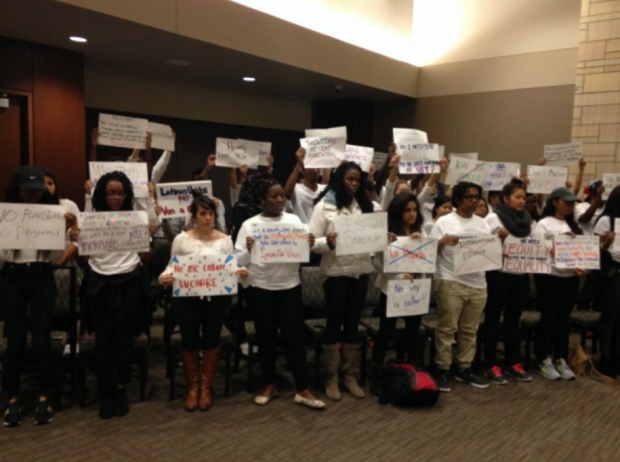
A new space in the Anderson Student Center will give students, staff and faculty a chance to gather, meet and learn more about diversity after recommendations by Students Of Color: Claim Our Seats and Campus Life’s evaluations of organization and club needs.
The Diversity Activities Board, a new group of faculty and students, was created through Campus Life and will use the new office space. The board will collaborate with other clubs on campus to provide educational programming about diversity for students. Margaret Cahill, St. Thomas’ director of Campus Life, said the overall goal of the DAB is to get more students engaged with each other.
“Our hope is that we’re bringing students together in a space differently than they are getting together now,” Cahill said. “It will be an office, but it will also be a gathering space. We want this to be a place where clubs can come and collaborate.”
Assistant Director of Campus Life Krysten Edwards, Student Diversity and Inclusion Services Program Director Jessica Gjerde and Intercultural Programs Manager for the Office of International Students and Scholars Othman Zaimi will advise six student interns for the DAB. Cahill said bringing these three offices together will combine different perspectives, backgrounds and knowledge.
“Instead of programming on top of each other or programming the same type of events, they will program together,” Cahill said. “More collaborative programming frees up resources, provides greater programs and gets more students engaged.”
Junior and SOCCOS member Mayzer Muhammad believes having student-led programs about diversity will be beneficial to the St. Thomas community.
“If these programs are run by students, there is a better chance that it will be received well because it will reflect on issues that students find concerning,” Muhammad said. “It empowers students to go out and make a change.”
The changes will also affect St. Thomas Activities and Recreation. STAR will focus on late-night and weekend social programming, while the DAB will create educational events with a social-justice lens and provide programming support to clubs that put on large cultural events like Africa Night and Hmong New Year.
“When you think about some of our cultural clubs, it is not necessarily their job to provide education to other undergraduate students. This provides some support, so they don’t have to do all of it,” Cahill said.
Muhammad hopes all students will take advantage of the educational programs the DAB will offer.
“It will hopefully engage students in conversations they haven’t had before,” Muhammad said. “Everyone is ignorant of something, and DAB is there to educate on issues students might not know about.”
While the DAB will provide programs on globalization and diversity, Cahill noted that all students should feel welcome coming into the space.
“A diversity activities programming board doesn’t program just for diverse students. It is providing a type of programming that is open to all students,” Cahill said.
Sophomore and SOCCOS member Deborah Honore believes the new office will create awareness on campus.
“This place is not only for students of color; it is for everyone. It is open ground for everyone to learn and share opinions,” Honore said.
Cahill said Campus Life is excited to create this space for students and that they will have to be flexible during the first year to evaluate the needs of the DAB.
“This will not address all of the space needs and requests from students, but from a programming standpoint, we think it will be successful,” Cahill said. “We are excited to be able to work together with SDIS and OISS in a way to respond to things that our students want and need and in a way that will have a really positive impact on our undergraduate students.”
The DAB will inhabit the space currently used by the Aquinas Yearbook staff on the third floor of the Anderson Student Center. The yearbook staff will move into the Hispanic, African American, Native American and Asian Association office. The new space will be completed before the fall semester begins.
Claire Noack can be reached at noac8702@stthomas.edu.


This a rather pessimistic view, but I feel like this “new space” is just another attempt by St. Thomas to say “look at what we have and how cool it is!”. The creative space sounds cool, but how much is it actually used? How often do you think clubs will actually “come and collaborate”? Why does this deserve its own office? Once again, I may not see the big picture, but I honestly don’t think actually going to do anything.
I think space sounds awesome! When I served on the German & Chemistry Club E Boards, we were always looking for clubs to collaborate with. However, we found it a challenge to engage with other clubs. Often it was cumbersome to have to email each club individually or we would plan an event just to find out another club was doing a similar event and we would have loved to collaborate. I think a space like this would have been very helpful to the clubs I was in and I’m glad to see that it now exists for future Tommies!
While education, awareness, and integration of diversity is a wonderful thing, I hope this club is careful to do so pastorally, respectfully, and with collegiality. “Everyone is ignorant of something,” is typically not the way you want to inform people of important issues. While this may be true, people tend to be turned off when you tell them they are ignorant.